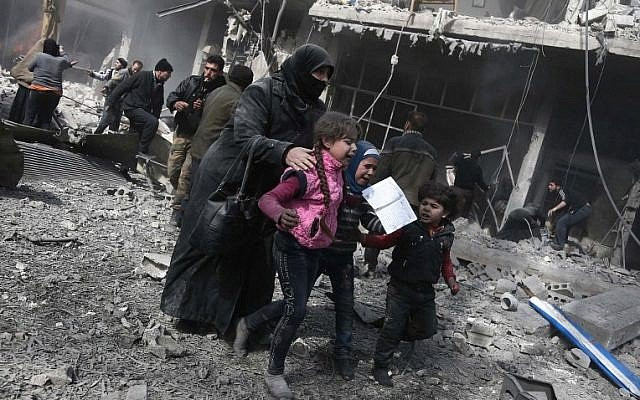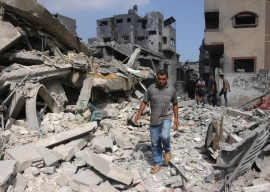
The onslaught has since retaken 70 per cent of Eastern Ghouta and killed nearly 1,260 civilians - a fifth of them children, according to the Syrian Observatory for Human Rights.
Here is a summary of events:
Government forces open a Russian-backed campaign against Eastern Ghouta with more than 260 rockets and intense air raids.
Syria regime enters key rebel-held Ghouta town: monitor
The strikes continue on February 19, when 127 civilians are killed in the highest single day death toll in Eastern Ghouta since 2013, when it was first besieged by the army.
On February 20, Russian air strikes reportedly target Eastern Ghouta for the first time in three months, hitting the key regional hospital in Arbin.
On February 21, raids target several areas and aircraft drop barrel bombs - crude, improvised munitions that cause indiscriminate damage.
The Kremlin denies carrying out air strikes.
United Nations chief Antonio Guterres says the region's residents are living in "hell on Earth".
Syria's Eastern Ghouta: 18 days under attack
On February 22 at the United Nations, Russia calls for a negotiated withdrawal of rebel fighters and their families, like the one that saw the government retake full control of Aleppo in December 2016.
Syria's UN representative Bashar al Jaafari confirms the comparison.
On February 24, the UN Security Council unanimously adopts a resolution demanding a 30-day ceasefire to allow for aid deliveries and medical evacuations.
But new air strikes and shelling batter the enclave for the following two days.
On February 26, Moscow announces that President Vladimir Putin has ordered a daily five-hour "humanitarian pause" from February 27 and the opening of protected corridors to allow people to leave.
Hours after the measure is meant to take effect, the United Nations says fighting has continued, making relief operations impossible.
A first attempt at delivering aid to the enclave is made on March 5, but is cut short due to heavy bombardment.
Despite the bombardment, on March 9 food aid is distributed in Douma, the largest town in Eastern Ghouta.
The following day the regime cuts off Douma from the rest of the enclave, managing to split the region into three: Douma and its surroundings in the north, Harasta in the west, and Saqba and Hammuriyeh in the south.
First fighters evacuated from Syria's Ghouta as food goes in
On March 11, it captures the town of Medeira, which lies between the three zones.
The regime sets up shelters and food distribution centres for the hundreds of civilians it has evacuated from newly recaptured areas.
On Monday, the United States presents a new draft resolution to the UN Security Council demanding a 30-day ceasefire.
The UN says more than 1,000 people, mostly women and children, are in urgent need of medical evacuation.
On March 15, the third convoy of aid in 10 days arrives in Douma.
Russia says it is committed to helping Syria's regime "finish off" rebels in Eastern Ghouta, leading the Pentagon to say Moscow is "complicit" in atrocities by Assad.
The same day, the Observatory says around 20,000 people have fled the enclave in "the largest displacement since the beginning of the assault on Ghouta." The UN is cautious about the number of displaced.
Using a corridor through Hammuriyeh, which the Observatory says the army has seized after rebels fled, the displaced flee on foot, in cars and on motorcycles.

















COMMENTS
Comments are moderated and generally will be posted if they are on-topic and not abusive.
For more information, please see our Comments FAQ